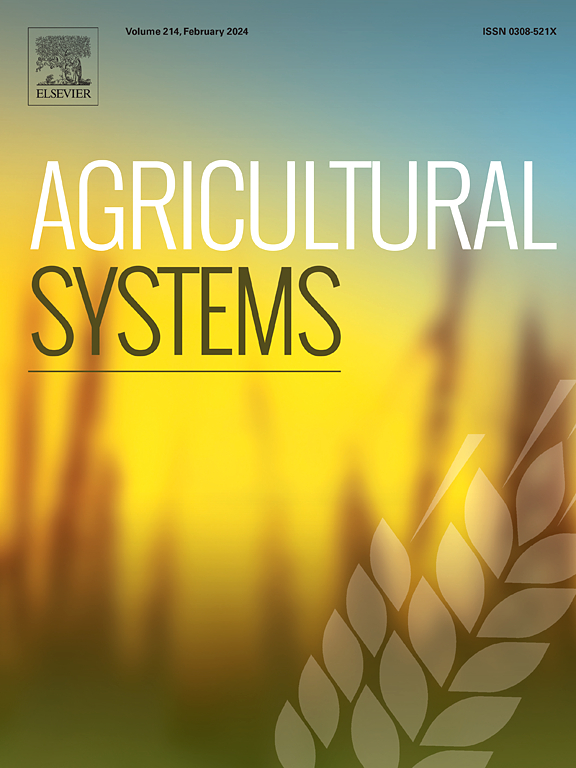中国耕地使用的时空变化对当地城市谷物供应的影响
IF 6.1
1区 农林科学
Q1 AGRICULTURE, MULTIDISCIPLINARY
引用次数: 0
摘要
当地谷物生产影响着城市粮食系统的可持续性。粮食自给问题在国家和地区尺度上都得到了广泛的研究。然而,以往的研究很少从土地利用变化的角度关注城市谷物供应。目的研究2000 - 2019年中国地级市城市谷物供应时空变化及耕地利用变化对城市谷物供应的影响。方法利用谷物(水稻、小麦和玉米)收获栅格数据、土地利用数据和统计数据计算城市谷物供应量。采用空间分析和地理时间加权回归模型(GTWR)研究了耕地利用变化对城市谷物供应的影响。结果与结论研究期间,中国各城市谷物供应量从27 × 104 t /年增加到113 × 104 t /年。耕地面积变化导致的城市谷物年供给量损失为678 × 104 t。劳动力成本、农药费用和排灌费用对城市谷物供应有正向影响,且劳动力成本系数不断增大。使农业投入物适应当地条件是必要的。本文设计了一个新的框架来描述耕地利用与城市谷物供应之间的关系,拓展了对中国城乡关系的理解,有助于实现联合国可持续发展目标。本文章由计算机程序翻译,如有差异,请以英文原文为准。

The impact of spatiotemporal change in cropland use on local urban cereal supply in China
CONTEXT
Local cereal production influences the sustainability of urban food system. Food self-sufficiency is widely studied on national and regional scale. However, few previous research focuses on urban cereal supply from a perspective of land use change.
OBJECTIVE
In this study, we studied the spatiotemporal change of urban cereal supply and the impact of cropland use change on urban cereal supply in Chinese prefecture-level cities from 2000 to 2019.
METHODS
This paper uses cereal (rice, wheat and maize) harvesting raster data, land use data and statistical data to calculate urban cereal supply. Spatial analysis and the geographically and temporally weighted regression model (GTWR) are used to investigate the impact of cropland use change on urban cereal supply.
RESULTS AND CONCLUSIONS
The results show that urban cereal supply of each Chinese city increases from 27 × 104 t to 113 × 104 t per year in the study period. The annual loss of urban cereal supply caused by cropland area change is 678 × 104 t. Labor cost, pesticide fee and drainage and irrigation fee have positive impact on urban cereal supply, and the coefficients of labor cost continuously increase. Adaptation of agricultural inputs to local conditions is necessary.
SIGNIFICANCE
This work designs a new framework to describe the relationship between cropland use and urban cereal supply, which expands the understanding of urban-rural relationship in China and will contribute to reaching UN'S sustainable target.
求助全文
通过发布文献求助,成功后即可免费获取论文全文。
去求助
来源期刊

Agricultural Systems
农林科学-农业综合
CiteScore
13.30
自引率
7.60%
发文量
174
审稿时长
30 days
期刊介绍:
Agricultural Systems is an international journal that deals with interactions - among the components of agricultural systems, among hierarchical levels of agricultural systems, between agricultural and other land use systems, and between agricultural systems and their natural, social and economic environments.
The scope includes the development and application of systems analysis methodologies in the following areas:
Systems approaches in the sustainable intensification of agriculture; pathways for sustainable intensification; crop-livestock integration; farm-level resource allocation; quantification of benefits and trade-offs at farm to landscape levels; integrative, participatory and dynamic modelling approaches for qualitative and quantitative assessments of agricultural systems and decision making;
The interactions between agricultural and non-agricultural landscapes; the multiple services of agricultural systems; food security and the environment;
Global change and adaptation science; transformational adaptations as driven by changes in climate, policy, values and attitudes influencing the design of farming systems;
Development and application of farming systems design tools and methods for impact, scenario and case study analysis; managing the complexities of dynamic agricultural systems; innovation systems and multi stakeholder arrangements that support or promote change and (or) inform policy decisions.
 求助内容:
求助内容: 应助结果提醒方式:
应助结果提醒方式:


